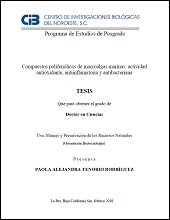Compuestos polifenólicos de macroalgas marinas: actividad antioxidante, antiinflamatoria y antibacteriana
Author
PAOLA ALEJANDRA TENORIO RODRIGUEZ
Metadata
Show full item recordAbstract
"En los últimos años, los productos naturales de origen marino y sus derivados han atraído la atención de la comunidad científica como fuente natural y novedosa de compuestos con potencial uso biotecnológico. En este sentido, las macroalgas resultan un interesante objeto de estudio debido a la riqueza algal con la que cuenta las costas de la Península de Baja California. Con el objetivo de valorar este recurso natural se seleccionaron especies de macroalgas marinas pertenecientes a tres grupos diferentes (Chlorophyta, Rhodophyta y Ochrophyta) y fueron analizadas por su contenido polifenólico y actividad antioxidante. A partir de los resultados obtenidos, los extractos de las macroalgas Eisenia arborea y Macrocystis pyrifera (Ochrophyta) fueron seleccionadas y fraccionadas para evaluar su actividad antioxidante, antiinflamatoria y antimicrobiana. La actividad antioxidante osciló entre los 12.7 ± 0.14 µM y 776 ± 1.32 µM de TROLOX g-1 de las cuales, las fracciones pertenecientes a E. arborea presentaron mayor actividad antioxidante (p<0.05). En general todas concentraciones de las fracciones evaluadas no afectaron significativamente la viabilidad celular in vitro (línea L9S29) siendo superior al 90%. En la actividad antiinflamatoria se observó un patrón similar en la producción de óxido nítrico (NO) en macrófagos RAW 264.7 que fue variable dependiendo de las fracciones de ambas especies. Dos fracciones fueron capaces de inducir un aumento en la expresión del gen IL-10, y disminuir la transcripción de los genes iNOS y TNF-α en macrófagos RAW 264.7 estimulados con lipopolisacárido (LPS), siendo mayor con la fracción 6 de E. arborea. En los ensayos de actividad antimicrobiana se emplearon seis cepas del complejo Mycobacterium: tres cepas pertenecian a M. tuberculosis (H37Rv, 46PP (fenotipo Beijing) y 96), dos cepas de M. avium subsp. paratuberculosis (V23 y ATCC® 19698), una cepa de M. bovis (303); y una cepa de Acinetobacter baumannii (144a). La concentración mínima inhibitoria (MIC) de las fracciones activas en ambas especies se encontró en el rango de 1.56- 37.5 µg mL-1 para las cepas del complejo Mycobacterium, donde la fracción 6 de E. arborea tuvo el espectro de acción más amplio. Ninguna de las fracciones fue capaz de inhibir el crecimiento de A. baumannii..." "In the last years, natural products from marine origin and their derivatives have attracted the attention of scientific community as novel source of compounds with potential biotechnological use. In this way, macroalgae are an interesting object of study due to the algal richness of the coast of the Baja California Peninsula. With the objective to assess this natural resource, marine macroalgae species belonging to three different groups (Chlorophyta, Rhodophyta and Ochrophyta) were selected and analyzed for their polyphenolic content and antioxidant activity. From the obtained results, extracts from the macroalgae Eisenia arborea and Macrocystis pyrifera (Ochrophyta) were selected and fractioned to evaluate their antioxidant, anti-inflammatory and antibacterial activity. The antioxidant activity ranged between 12.7 ± 0.14 μM and 776 ± 1.32 μM of TROLOX g-1, in all the cases E. arborea’s fractions showed higher antioxidant activity (p <0.05). In general, all concentrations of the fractions evaluated did not significantly affect cell viability in vitro (line L9S29), being greater than 90%. In the anti-inflammatory activity a similar pattern was observed in the production of nitric oxide (NO) in macrophages RAW 264.7 that was variable depending on the fractions of both species. Two fractions were able to induce an increase in the expression of the IL-10 gene, and decrease the transcription of the iNOS and TNF-α genes in RAW 264.7 macrophages stimulated with lipopolysaccharide (LPS), being higher with fraction 6 of E. arborea. In the assasyes of antibacterial activites, six strains of the Mycobacterium complex were used: three strains belonged to M. tuberculosis (H37Rv, 46PP (Beijing phenotype) and 96), two strains of M. avium subsp. paratuberculosis (V23 and ATCC® 19698), a strain of M. bovis (303); and a strain of Acinetobacter baumannii (144a). The minimum inhibitory concentration (MIC) of the active fractions in both species was found in the range of 1.56- 37.5 μg mL-1 against the strains of the Mycobacterium complex, where fraction 6 of E. arborea had the broadest spectrum of action. None of the fractions was able to inhibit the growth of A. baumannii..."
Collections
Related items
Showing items related by title, author, creator and subject.
-
PROMOCIÓN DEL PERIFITON PARA EL CULTIVO DE CAMARÓN BLANCO: HACIA UNA ACUICULTURA ECOLÓGICA
DOMENICO VOLTOLINA LOBINA; JUAN MANUEL AUDELO NARANJO; MARIA DEL ROSARIO PACHECO MARGES -
Suelo y Erosión
YOLANDA LOURDES MAYA DELGADO


